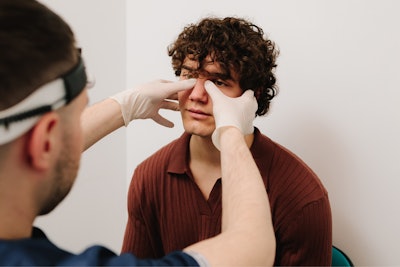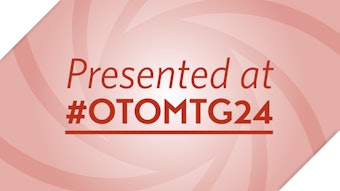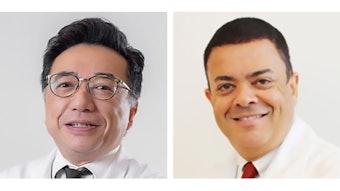Frontal Sinus Frontiers: The Rise of the Hybrid Approach
Innovations in rhinologic techniques may simplify the notorious challenges of optimizing success in frontal recess surgery.
Jordan Teitelbaum, DO, on behalf of the Rhinology and Paranasal Sinus Committee

Understanding frontal sinus anatomy is an essential part of frontal disease management, whether acute or chronic.2,3 Thus, a great deal of recent research has gone into classifying the frontal sinus anatomy, achieving and maintaining frontal sinus patency, and educating regarding technical approaches.1-3
Concurrently, rhinologic procedural trends have seen a huge surge in balloon catheter dilation (BCD) of the paranasal sinuses since they were approved by the FDA just 20 years ago.4 BCD was developed to widen sinus ostia while potentially decreasing recovery time and postoperative discomfort. The procedure rapidly gained both significant momentum and controversy within the specialty community.5 Our Academy then released a Clinical Consensus Statement on Balloon Dilation in 2018, outlining indications and contraindications as well as citing safety and efficacy, but nevertheless encouraging proper patient selection for this new technology.6
Using balloon dilation to access the frontal sinus, which sits at a difficult anatomical angle, has also gained considerable traction. A survey study in 2024 demonstrated nearly 80% of respondent surgeons report using the balloon for frontal sinus procedures.7 However, especially given the inherent narrowness of the frontal os and the risk for restenosis, the question becomes: Is balloon dilation enough to truly open an obstructed frontal sinus?4
The exciting development in our literature and in anecdotal practice throughout the past several years is the amalgamation of a hybrid frontal technique (HFT)—that is, using balloon catheter technology (BCT) along with more traditional ESS methods to perform comprehensive frontal sinus surgery. The authors of this approach cite that the balloon allows maximal mucosal preservation as well as citing its deftness in accessing a complex recess.8 Since its introduction, HFT has been presented as a case report for a chronic rhinosinusitis with nasal polyps case,9 a case series for various pathologies,10 and even as a randomized, controlled trial.11
Surgeons describe using the balloon as an “assist” for opening the infundibulum, crushing cells before resection/removal, and at times simply finding the os itself with lighted-wire guidance or stereotactic image-guidance. In all these reports, traditional cold steel instruments and/or microdebriders were used. In the RCT, one side was operated on traditionally while the other was first balloon-dilated; this study reported less blood loss and equivalent postoperative patency on the hybrid side.11
Although BCD may have been traditionally thought of as a tool to treat milder chronic sinusitis, such as for in-office procedures, is it possible that the frontal balloon may prove an exceptional tool to help operate on frontal sinus disease via HFT?
Potential uses in addition to cases with complex anatomy include using the hybrid technique in otolaryngology training. This may decrease operative time by aiding safer identification before handheld steel instruments are introduced. Certainly, considerations of visualization, preserving mucosa, and preventing scar formation are paramount in these delicate dissections for surgeons of any level.12,13 However, the drawbacks and challenges include operative costs, industry impacts, and the ongoing controversy over following proper BCT indications.14,15 Lastly, the concern may arise that over-reliance on navigated technologies may reduce clinical understanding and take away from the spirit of a true frontal dissection.
Nonetheless, with the exciting uptrend in user-friendly balloon dilation models as well as the recent efforts toward frontal classification and education, it may be helpful for us to consider, trial, and potentially promote the hybrid frontal sinus technique as we continue to pursue excellence in surgical care for patients with frontal sinus pathology.
References
- Wormald PJ, Hoseman W, Callejas C, et al. "The International Frontal Sinus Anatomy Classification (IFAC) and Classification of the Extent of Endoscopic Frontal Sinus Surgery (EFSS)." International Forum of Allergy & Rhinology 6, no. 7 (July 2016): 677-96.
- Wormald PJ. "Surgery of the Frontal Recess and Frontal Sinus." Rhinology 43, no. 2 (June 2005): 82-85.
- Saini AT, Govindaraj S. "Evaluation and Decision Making in Frontal Sinus Surgery." Otolaryngologic Clinics of North America 49, no. 4 (August 2016): 911-25.
- Stewart AE, Vaughan WC. "Balloon Sinuplasty versus Surgical Management of Chronic Rhinosinusitis." Current Allergy and Asthma Reports 10, no. 3 (May 2010): 181-87.
- Batra PS, Ryan MW, Sindwani R, Marple BF. "Balloon Catheter Technology in Rhinology: Reviewing the Evidence." Laryngoscope 121, no. 1 (January 2011): 226-32.
- Piccirillo JF, Payne SC, Rosenfeld RM, et al. "Clinical Consensus Statement: Balloon Dilation of the Sinuses." Otolaryngology–Head and Neck Surgery 158, no. 2 (February 2018): 203-14.
- Lofgren DH, Knight BB, Shermetaro CB. "Contemporary Trends in Frontal Sinus Balloon Sinuplasty: A Pilot Study." SMRJ 9, no. 3 (2024): 8-13.
- D'Anza B, Sindwani R, Woodard TD. "Innovations in Balloon Catheter Technology in Rhinology." Otolaryngologic Clinics of North America 50, no. 3 (June 2017): 573-82.
- Christmas DA, Mirante JP, Yanagisawa E. "Hybrid Frontal Sinus Surgery with Balloon Dilation and Microdebrider Resection." Ear, Nose & Throat Journal 94, no. 8 (2015): 304-5.
- Fleischman GM, Miller JD, Kim GG, et al. "Treatment of Chronic Frontal Sinusitis with Difficult Anatomy: A Hybrid Balloon Technique in Four Cases." Allergy & Rhinology 5, no. 3 (January 2014): 120-24.
- Hathorn IF, Pace-Asciak P, Habib AR, et al. "Randomized Controlled Trial: Hybrid Technique Using Balloon Dilation of the Frontal Sinus Drainage Pathway." International Forum of Allergy & Rhinology 5, no. 2 (February 2015): 167-73.
- Eloy JA, Svider PF, Setzen M. "Preventing and Managing Complications in Frontal Sinus Surgery." Otolaryngologic Clinics of North America 49, no. 4 (August 2016): 951-64.
- Tajudeen BA, Adappa ND. "Instrumentation in Frontal Sinus Surgery." Otolaryngologic Clinics of North America 49, no. 4 (August 2016): 945-49.
- Koester LK, Goyal P. "Utilization and Reimbursements for Sinus Procedures: A Five-Year Analysis." Laryngoscope 129, no. 10 (October 2019): 2224-29.
- Calixto NE, Gregg-Jaymes T, Liang J, Jiang N. "Sinus Procedures in the Medicare Population from 2000 to 2014: A Recent Balloon Sinuplasty Explosion." Laryngoscope 127, no. 9 (September 2017): 1976-82.











